

Getnews.jpg (JPEG Image, 800 × 671 pixels) Millennial media-consumption habits explained, in 5 charts. Everyone, marketers and brands included, is obsessed with millennials.
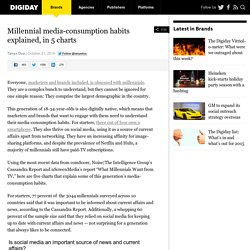
They are a complex bunch to understand, but they cannot be ignored for one simple reason: They comprise the largest demographic in the country. This study finds that social media use reduces political polarization instead of increasing it. Nov. 25, 2014, 1:35 p.m.
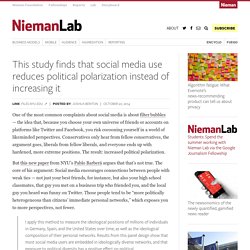
First Look Media announced today that Racket, the political satire magazine originally headed by Matt Taibbi, is shutting down. Since Matt Taibbi’s departure, we’ve been working with the team he hired to consider various options for launching a project without him. After multiple explorations, we’ve decided not to pursue the project.
Unfortunately, this means that the team Matt hired will be let go. The announcement follows weeks of seeming instability at the company. The mistakes publishers make with mobile apps. In case you haven’t heard, the Web is dying and apps won.
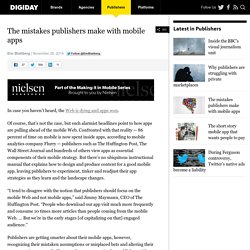
Of course, that’s not the case, but such alarmist headlines point to how apps are pulling ahead of the mobile Web. Confronted with that reality — 86 percent of time on mobile is now spent inside apps, according to mobile analytics company Flurry — publishers such as The Huffington Post, The Wall Street Journal and hundreds of others view apps as essential components of their mobile strategy. But there’s no ubiquitous instructional manual that explains how to design and produce content for a good mobile app, leaving publishers to experiment, tinker and readjust their app strategies as they learn and the landscape changes.
“I tend to disagree with the notion that publishers should focus on the mobile Web and not mobile apps,” said Jimmy Maymann, CEO of The Huffington Post. Abusing push notifications. “Most developers are using push notifications as blunt objects, as opposed to a true asset. La lecture numérique s'impose chez les cadres. L'étude AudiPresse montre une hausse de l'audience de la presse.

With ‘The Economist’ and the ‘Financial Times’ Now Selling Ads Based on Time Spent, Who’s Next? Two of the smartest publications in the world are now experimenting with replacing the pageview with a new dominant metric for setting the price for ads bought and sold on the web.

That metric? Time spent in view. Last week, The Wall Street Journal‘s Suzanne Vranica reported The Economist will start selling ads based on a new program called “TimeGuarantee,” which ensures that readers will spend at least 250 hours with an ad in view on The Economist’s digital platforms, such as its app. This move follows the lead of the Financial Times, which announced a similar currency in early June. “We have a hypothesis we want to prove: that the longer you show somebody a piece of brand creative, the more resonance that piece of content has with an audience,” Jon Slade, commercial director of digital advertising at the Financial Times, told us in June. Mobiles et réseaux sociaux ont pris les clés de l’info. Et c'est Facebook qui a le trousseau !

How to build an audience. We know what readers are doing on our sites.
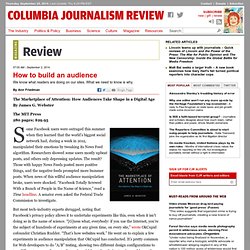
What we need to know is why. The Marketplace of Attention: How Audiences Take Shape in a Digital Age By James G. Webster The MIT Press 280 pages; $29.95. How social media is reshaping news. The ever-growing digital native news world now boasts about 5,000 digital news sector jobs, according to our recent calculations, 3,000 of which are at 30 big digital-only news outlets.

Many of these digital organizations emphasize the importance of social media in storytelling and engaging their audiences. As journalists gather for the annual Online News Association conference, here are answers to five questions about social media and the news. How do social media sites stack up on news? When you take into account both the total reach of a site (the share of Americans who use it) and the proportion of users who get news on the site, Facebook is the obvious news powerhouse among the social media sites.
Roughly two-thirds (64%) of U.S. adults use the site, and half of those users get news there — amounting to 30% of the general population. 8 bonnes pratiques pour profiter du boom des mobiles. Par Etienne Cointe et Mathias Virilli, France Télévisions, Direction de la Prospective A l’occasion de la sortie de l’iOS 8, Ad4Screen* nous rappelle les bonnes pratiques à avoir sur les terminaux mobiles, promis à un bel avenir.
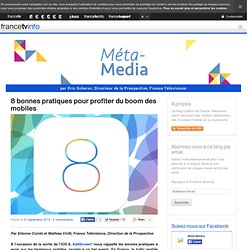
En France, le trafic mobile représente 30% de la navigation Internet aujourd’hui et devrait logiquement dépasser l'ordinateur dès 2015. La France voit son nombre de mobinautes augmenter : elle en compte aujourd’hui 27,7 millions - 17,5 millions d’utilisateurs smartphones et 8 millions de tablettes. La tablette, présente dans 1 foyer sur 3, a connu un boom de croissance de 94% sur l’année. Introducing Save on Facebook. By Daniel Giambalvo, Software Engineer.

16 reasons why this research will change how you look at news consumption. Most research on news consumption annoys me. Most research on news consumption – like Pew’s State of the News Media – relies on surveys of people self-reporting how they consume news. But surveys can only answer the questions that they ask. And as any journalist with a decent bullshit detector should know: the problem is people misremember, people forget, and people lie.
» Study: Print readers recall more news than online readers JIMROMENESKO.COM. A study by University of Houston professor and former newspaper journalist Arthur Santana finds that people remember more news when they read it in print. “In essence, print newspapers are a more effective medium than online newspapers at spurring recollection,” he says. In his test… Participants were not told that their ability to recall news stories would be tested. One group read the print edition of The New York Times while the other group read the same day’s online version.After 20 minutes of reading, participants were asked to note the headlines, general topics and main points of as many stories as they could remember. Print readers remembered an average of 4.24 news stories while online readers recalled an average of 3.35 stories, according to the research.
16 reasons why this research will change how you look at news consumption. » Study: Print readers recall more news than online readers JIMROMENESKO.COM. The FT on attention minutes: 'We're properly valuing the expensive engagement we create' This is part of a series of articles focused on the key issues that will be covered in our Monetising Media event at the end of September. When news broke earlier this summer that the Financial Times was experimenting with a new way of selling ads based on a currency of "attention minutes" rather than impressions or clicks, the rest of the industry was intrigued.
New York Times creates responsive app with traditional print feel. 08 September 2014 · By Tom Kulaga “Today’s Paper” app delivers tradition with a twist, mirroring the print edition in organisation, structure, even font. Ten months into its release, the HTML5 app is engaging readers and driving new subscriptions for those who want a print feel on their tablet or desktop. The New York Times has long been a leader in the media industry’s transition to the Digital Age. At the same time, however, The Times remains committed to delivering its news, information, and entertainment content in ways that meet the needs of all its users, both print and digital. Email renaissance: drive website traffic via e-newsletter, everybody's doing it. More and more news sites are keeping their readers informed with daily emails.
Despite emails being in circulation since 1993, email marketing is the 'hot new thing', according to just about everybody. A recent survey by Quartz found that the email inbox is one of the first forms of news people access each day, and 80% of survey respondents reported that they choose email as the platform via which they share content.
So it is no wonder that news sites around the world are all turning to email updates to curate and share news. Social Media and the ‘Spiral of Silence’ A major insight into human behavior from pre-internet era studies of communication is the tendency of people not to speak up about policy issues in public—or among their family, friends, and work colleagues—when they believe their own point of view is not widely shared. This tendency is called the “spiral of silence.” Some social media creators and supporters have hoped that social media platforms like Facebook and Twitter might produce different enough discussion venues that those with minority views might feel freer to express their opinions, thus broadening public discourse and adding new perspectives to everyday discussion of political issues.
We set out to study this by conducting a survey of 1,801 adults. It focused on one important public issue: Edward Snowden’s 2013 revelations of widespread government surveillance of Americans’ phone and email records. This survey’s findings produced several major insights: A rundown of the key survey findings: About this Report Keith N. The U.S. Mobile App Report. Les Britanniques font plus confiance à Wikipédia qu'aux médias. Le cofondateur de Wikipédia, Jimmy Wales, s'est félicité dimanche d'un sondage montrant que les Britanniques faisaient plus confiance à l'encyclopédie en ligne participative écrite par des volontaires... qu'aux médias professionnels. "Les Britanniques font plus confiance à Wikipédia qu'aux médias. C'est quelque chose que nous avons accompli", a-t-il lancé lors de la cérémonie de clôture de "Wikimania", la conférence internationale annuelle de la Fondation Wikimedia.
L'homme d'affaires américain s'est appuyé sur un sondage publié samedi par l'institut YouGov. Celui-ci indique que 64 % des 2 000 personnes interrogées font confiance aux auteurs de Wikipédia en ce qui concerne la véracité de ce qu'ils écrivent. Et que ce chiffre descend à 61 % pour les journalistes de la BBC, à 45 % pour la presse quotidienne dite sérieuse comme le Times ou le Guardian et à 13 % pour les tabloïds tels que le Sun. "C'est même un peu effrayant" Is tracking engaged time the secret to measuring media effectiveness, or is it just another blind alley?
As media companies and advertisers search for better ways of measuring the effectiveness of content, a lot of attention has been focused on what some like to call “engaged time.” Designed by companies like Chartbeat, the publishing-analytics company, Upworthy — which recently open-sourced its “attention minutes” measurement — and the Financial Times, these metrics try to measure the time that a reader actually spends with a story instead of just tracking clicks. But is engaged time a red herring? ProPublica president and former Wall Street Journal assistant publisher Dick Tofel thinks it might be. Tofel lays out his argument in an essay he wrote for the Media Impact Project, a venture launched by the USC Annenberg School for Communication and Journalism that’s trying to improve the theory and practice of media measurement.
You gotta read this! — Maker’s Perspective. Back in May Mike Hudack posted a rant about the state of the news media. The gist of it is: here we are in 2014, the Internet is at scale — the mobile internet is in the pockets of 30%+ of adults worldwide and social networks are at a proportionate scale and yet the news media seems to be becoming more and more dumb. Put another way: the world of news creation and access have been blown open and yet most news organizations have hollowed out their news capabilities and are posting the trivial listicles about “28 young couples you should know”. The response was interesting — one reason is Mike works at Facebook. The Biggest Facebook Publishers of June 2014. We list the most successful sites on Facebook last month, with a detailed breakdown of the interactions that the top 25 publishers received in June. The news about reader attention and the evolution of media isn’t all bad — there’s the “hill of Wow”
The news about reader attention and the evolution of media isn’t all bad — there’s the “hill of Wow” Why The News is Slowly Killing You. People Are Sharing More News Than Ever On Facebook. The digital divide: 5 things we know about how younger generations consume media. SPS : Etude sur les comportements de lecture :Papier versus numérique. Presse Edition 02/07/2014 Afin d’aider ses adhérents à relever le défi de la refonte de leurs dispositifs de communication, le SPS -Syndicat de la Presse Sociale*- a fait réaliser par l’agence Seprem Etudes et Conseil courant mai 2014, une étude en ligne auprès d’un échantillon représentatif de la population française de 1.165 individus. . • Méthodologie et tous les résultats de cette étude sur le site du SPS www.sps.fr* Le Syndicat de la presse sociale (SPS) rassemble :- 100 éditeurs (mutuelles, syndicats et associations) - représentant plus de 120 publications, - qui touchent près de vingt millions de lecteurs.
What is Engaged Time? How Important is Sharing for Premium Content? As you know, Baekdal Plus (this site) is a premium content site, in which my subscribers pay $9/month for articles and reports covering strategic advice for people in the media and marketing industries. The site itself is built around a paygate. Microsoft Word - News Report 2014 140624 to webmaster.dotx - News_Report_2014.pdf. The Code [Literally] To What Lies Between The Click And The Share. Yours, For Free... Really. - Upworthy Insider.